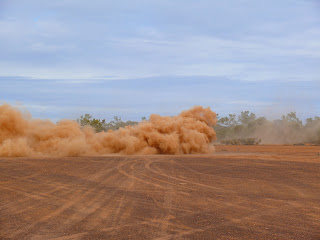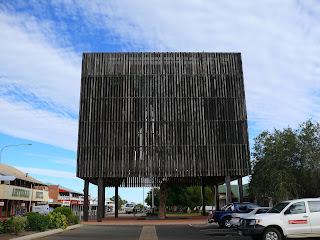Big Trip Begins
Mon 3/6/2013 Brisbane to Chinchilla
It was good to leave a the hustle and bustle of vehicles and Brisbane freeways behind and get into open country. Much of the blacktop was quite narrow and in very “ordinary” condition with lots of patching up that made the road bumpy however there was also lots of road work restructuring and resurfacing the road (for which we had to stop a number of timers) so it will be much better in the future. The drive into Toowoomba is very steep. We were glad that we had not filled the caravan water tank up at that stage. Another man in a caravan told us that he, knowing the road, deliberately hadn’t filled his van’s water tank or his cars petrol tank before going up the hill. After Toowoomba the country side flattened out. The Darling Downs are very rich agricultural lands. We saw cotton fields, which Gerd kept calling wool fields.


There were lots of coal trains running from out west back towards Brisbane. We stopped in Dalby for lunch and I bought a new book with free/cheap campsites throughout Australia. We will need a few free ones to pay for the price of the book!
We camped in the Chinchilla show grounds (power $25 P.N.). I was glad of the electricity for our heater because it was a very cold night.
Tues 4/6/2013 Chinchilla to Roma
Before leaving Chinchilla we went to the i Centre. I discovered that Chinchilla is world famous for its fossilised wood. I bought a fossicking licence ( family x 1 month $9) and paid $6 to go onto a fossicking area on a private farm - and out we went for a couple of hours. We did not dig, just fossicked over the surface and collected a full bag (to Gerd's distress, though he enthusiastically helped collect) of pieces that could be tumbled or cut and polished.
The country towards Roma was very flat, covered with small trees. There was a lot of traffic, especially big trucks, road trains, and mine/gas exploration vehicles.
When we arrived in Roma we went to the i Centre for brochures about the area. We were told about the show at the centre in the evenings called ‘The Big Rig” about the history of exploration for water/gas/oil in the Roma area. For $7 it was a great show.
We camped in the Roma show grounds (power $25 P.N.).
Wednes 5/6/2013 Roma
The morning was dedicated to washing and shopping.
Bottle trees are a feature of Roma. These bottle trees are NOT the boabs of Western Australia! They have a pithy centre but the name comes from their distinctive shape. There is an avenue of bottle trees in the centre of the town dedicated to the memory of WW1 servicemen. I found one dedicated to the memory of S. DeVere. My grandmother’s maiden name was DeVere - and it is an unusual name in Australia - so he may have been a relative.
We drove to the largest bottle tree in Roma to measure ourselves against its girth.
Later we inspected the Roma cattle sale yards, said to be the largest in the southern hemisphere. We watched cattle being loaded onto double decker road trains for shipment to Victoria. Some of the beasts did not want to go travelling and had to be helped to comply with a little prodding from the “zap” sticks. There was one animal that was particularly contrite and preferred to charge the gate, and the handlers, and to jump over the other cattle to try to get out.
In the evening Gerd watched NSW beat Qld in the State Of Origin game using my computer.
Thurs 6/6/2013 Roma to Carnarvon Gorge
The road varied from very patched to brand new resurfacing still without line makings.
Between Injune and the Carnarvon Gorge turnoff the country is very beautiful with high
sandstone bluffs and beautiful vistas. There was lots of road kill - mostly small kangaroos. The drive into the National Park is suitable for normal vehicles and most, but not all, is sealed. On the way in we saw three brolgas strutting across the road. The Takarakka Bush Resort camp ground is attractive. After setting up camp we drove to the Visitors Centre for a map and explored the Rock Pool, and Baloon Cave which features aboriginal rock art. Back in camp we attended the Ranger’s briefing to find out the best plan of attack for walking the gorge in the morning.
We camped in the Tararakka camp ground (power $45 P.N. -it is peak season)..
Fri 7/6/2013 Carnarvon Gorge
The Carnarvon Gorge has white sandstone cliffs which tower above a boulder strewn creek. The banks are lush with vegetation and feature an abundance of fan palms and cycads. We followed the main track which criss crosses the creek many times, using boulders as stepping stones.
The side gorges have special features and are a major attraction of the walk. First we inspected the aboriginal paintings, stencil art and engravings at the Art Gallery, which is thought to be a women’s sacred area.
Next we climbed the steps which wind around a small waterfall to Ward’s Canyon. It is an miniature Edenic area and not to be missed. Next, the Amphitheatre is entered through a narrow slot in the rocks and then opens out into a 60m deep chamber. The rock layers and their faults are a stone time line. It is spectacular!
Finally we visited the Moss Garden where ancient water from the water table continually seeps out between the impermeable basalt layer below and the sandstone above. There is a small waterfall that splashes into a plunge pool. The sunlight only penetrates when directly overhead and as a result the area is covered in moss and ferns.
We left on our “walk” at 9:00am, stopped for 20 minutes for lunch at the point we thought it necessary to turn around or we could be walking home in the dark, and finally got back to the carpark at 4:30pm - over seven hours of walking and about 17 kms. We were tired, but not totally exhausted. On return to the caravan park we went over to listen to the ranger give his talk (again). He is an interesting speaker. A yummy meal, and a hot shower completed a great day.
Sat 8/6/2013
We slept in until disturbed by a flock of very noisy birds which settled and squabbled outside our van. After breakfast we took a cut lunch and set off to explore Mickey Creek Gorge. First we took the left hand arm of the gorge which ends in an attractive green fern filled grotto and then returned to the cross road and took the arm towards Warambah Gorge. Having been told by the ranger to do so, we continued on past the “End of the formed track” marker. We edged around a small water pool and entered a narrow slot canyon which is the doorway into a different world. The narrow canyon has high, green moss covered walls, a damp boulder covered floor with intermittent pools of water that need to be negotiated by rock hopping or wall ledge shuffling and clinging. It is an indescribably magical place that must be seen and experienced. We went in as far as we could without putting our selves or cameras in danger - or getting too dirty slipping down rocks. A highly recommended adventure!

After lunch in the park at the Visitors Centre we took the short Nature Walk trail along the creek. I found a beautiful purple fungi which I duly photographed and then, birds and water reflections which also made great photo material.
On return to the camp ground we walked up to the lookout to view the surrounding peaks.
The finale of the day was a plate of fresh passionfruit pulp and ice cream. Who could ask for a better Sabbath day!
Sun 9/6/2013
Today we travelled from Carnarvon NP to Rubyvale in the Queensland gemfields.
We passed through Rolleston and stopped at the park next to the i Centre to look at a monument made from a great pile of petrified wood - full tree stumps!. the i Centre attendant told me that petrified wood is very abundant in the area and collectors come from all over the world because of its quality.
The next town, Springsure - named because of its secure water supply, sits beneath a very impressive bluff. The majestic landscape is due to the fact that this was once an active volcanic area. It was such an overcast day I didn’t take any photos but I have put it on our agenda for exploration at a future date.
Sapphire and Rubyvale are mining town with the same ugly appearance as Coober Pedy but tomorrow we are going to look under the earth for treasure!!
Monday 10/6/2013
Today we went on a tag-along (drive yourself) sapphire digging tour. Gerd did a lot of digging but not in the right spot! We were not very successful in finding sapphires. Some of the others got a couple of nice ones, we got a couple of small ones but it was fun. We came home very dirty and Gerd was worn out.
Tues11/6/2013
Today we washed our dirty clothes and then we went to look at gem dealers shops. On the way we stopped and photographed 4 brolgas strolling along the main road through Rubyvale. At the second shop some ladies were busy sorting through bags of “wash”, the gravel and soil mix in which sapphires are found. You can buy bags of wash if you don’t want to do, or can’t do, the hard work of digging it up yourself. They were having some success so we bought a bag and started sorting. It's a gamble what treasure you might find therefore it is a very addictive activity ... so we did the second bag ... and the third bag.

We have a tiny bag of sapphires and zircons to commemorate our time here. In the afternoon we drove 36 km to see the Tomahawk fossicking site. We drove past a number of old volcano cones, which were the source of the gems. The Tomahawk fields requires the removal of boulders the size of footballs or greater for about a metre in depth before you hit the “wash” - the bed of the ancient stream which carried the sapphires. In a fossicking area only hand tools can be used. The fossickers work very hard to obtain their treasure.










































